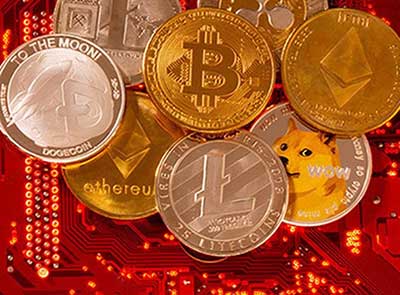Relevance: GS-3: Indian Economy, mobilization of resources, changes in industrial policy and their effects on industrial growth.
Key Phrases: Digital Assets, Crypto currency, Digital Currency Bill, 2019, Crypto currency and Regulation of Official Digital Currency Bill, 2021, Non fungible token, Indian economy, Blockchain Technology, Anti-Money Laundering, FATF, Investor Protection, High Volatility, Single Regulator, CBDCs.
Why in News?
- It’s a challenge as there’s no defined way to regulate to the digital assets.
Context:
- Regulation of ‘digital assets’ has been a hot potato for several years.
The challenge has been the pace of technological evolution in this space —
before one use-case can be assessed by regulators, other use-cases emerge,
posing fundamental questions for policymakers — that is,
- How to define the space.
- Create ‘triggers’ to regulate conduct.
- Whether to licence and regulate.
- Challenge with any digital law globally has been in containing technology through legal concepts like definitions. Banning of Cryptocurrency and Regulation of Official Digital Currency Bill, 2019, which proposed to ban cryptocurrencies in the country, similarly provided for an expansive definition of ‘cryptocurrencies’, raised many questions, and a similar question may arise as and when the text of the Cryptocurrency and Regulation of Official Digital Currency Bill, 2021 is made public.
Virtual Digital Asset
- In the explanatory memorandum of the Finance Bill 2021, the government stated, “To define the term “virtual digital asset”, a new clause (47A) is proposed to be inserted to section 2 of the Act.
- As per the proposed new clause, a virtual digital asset is proposed to mean any information or code or number or token (not being Indian currency or any foreign currency), generated through cryptographic means or otherwise, by whatever name called, providing a digital representation of value which is exchanged with or without consideration, with the promise or representation of having inherent value, or functions as a store of value or a unit of account and includes its use in any financial transaction or investment, but not limited to, investment schemes and can be transferred, stored or traded electronically. Non fungible token and; any other token of similar nature are included in the definition.”
Why India want to regulate digital Asset?
- The RBI considers the Digital assets or cryptocurrency as a risk to rupee, having the capability of weakening the Indian economy and ruining government attempts at crackdown on unlawful flow of money for illegal and illegitimate activities.
- Further, since such virtual currencies based on blockchain technology are exceptionally secure, it makes it extremely tough to track down the inception of a transaction. This in turn increases the possibilities of the virtual currencies being used for banned and forbidden pursuits.
- One of the key regulatory concerns is anything that could become a national security issue. In this aspect, the regulators fear the misuse of Digital assets using its anonymity for weakening its anti-money laundering efforts. India, being a part of the Financial Action Task Force (FATF), has to abide by its standards that seek global cooperation between sovereign member nations.
- On the other hand, investor protection is always an important mandate of financial regulators. From regulatory perspective, Digital assets are currently seen with suspicion about its intent-of-existence, as well as being observed as overtly speculative asset, without any underlying value to it. With over 10,000 crypto currencies in global circulation, and most of them with high volatility of value and trading volumes, global regulators will need to boost their investor safeguard measures, until they either ban them or regulate them tightly.
Government regulation on virtual digital assets
- The government introduced broadly three measures on taxation of virtual digital assets.
- First, income from the transfer of virtual digital assets will be taxable at a flat rate of 30%, without the ability to offset it against any other losses. No deductions will be allowed and only the cost of acquisition will be allowed as deduction while computing income.
- Second, it introduces the requirement for the tax to be deducted at source at the rate of 1% on payment to a resident on the transfer of virtual digital assets.
- Third, a gift of virtual digital assets will be taxable at the hands of the recipient.
Lessons from previous Action:
- The lessons from these approaches are clear. Regulating digital assets is not the exclusive domain of a single regulator. The experience so far has shown that a policy response to digital assets will pose a never before seen challenge, requiring understanding the risks first, before taking a licensing or regulatory approach, which are readily available options for law makers.
- Regulators would have to visualise the far-reaching use of technology in the regulated services to first understand use-cases and attendant risks, and then regulate the digital revolution underway. Conventional means to rule-making may defy regulation of digital assets and get constrained by regulatory silos, turfs, domain and legal limitations.
- CBDCs can be the first (and not the only) natural response to regulated digital assets. Anything that becomes an exclusive domain of the sovereign will stifle innovation. The ongoing digital assets revolution is beyond just crypto-currencies as an investment or asset class, and the underlying technology and its evolution deserve to be recognised for legitimate use.
Way forward:
- India is on the cusp — never before has a topic seen such interest, on this sustained a basis. The policy-making must follow a detailed study of the risks, opportunities and challenges posed by the current digital assets revolution. This is India’s moment to show leadership in regulation and promote innovation.
Source: The Hindu BL
Mains Question:
Q. “The regulation of virtual digital assets in India is Hercules task”. Critically analyse the statement. (250words).








